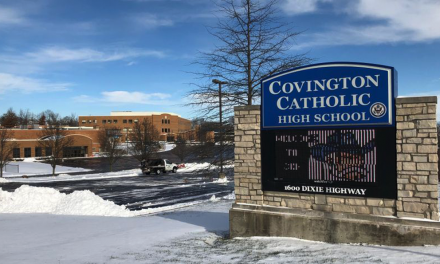The so-called “wall of separation between church and state” has done more damage to America’s religious and moral tradition than any other utterance of the Supreme Court. While the First Amendment was originally intended to prevent the establishment of a national religion and thus ensure religious liberty, the Supreme Court’s misuse of the “separation of church and state” phrase has fostered hostility toward, rather than protection of, religious freedom.
This phrase has been used by the Court to outlaw Ten Commandments displays in public buildings, prayer and Bible reading in schools, clergy and even student invocations at school events, and other public acknowledgements of God. Such decisions clearly negate the Founding Father’s presupposition of America’s Christian identity. It is time to return the First Amendment back to its original meaning and revive the rich faith-filled heritage of America’s public life.
National Religion
Many of the state legislatures that ratified the Constitution conditioned their approval on the further inclusion of a guarantee of individual liberties such as the freedom of religion. Some of those states already had taxpayer-supported “establishments” of religion. The new Congress took up these calls for action and drafted the Bill of Rights for further approval by the states. James Madison, a major participant in the debate and drafting of what ultimately became the First Amendment, introduced the initial draft on June 8, 1789 as discussions began in the House:
The civil rights of none shall be abridged on account of religious belief or worship, nor shall any national religion be established, nor shall the full and equal rights of conscience be in any manner, or on any pretext, infringed.
After further discussion, other versions of the amendment were offered, including: “no religion shall be established by law,” “no religious doctrine shall be established by law,” “no national religion shall be established by law” and “Congress shall make no laws touching religion.” Finally, the House sent back to the Senate this version: “Congress shall make no law establishing religion.” The Senate took the House version under advisement, but then offered its own version: “Congress shall make no law establishing articles of faith or a mode of worship, or prohibiting the free exercise of religion.” When the House and Senate met to resolve their differing versions, they settled on the ultimate version of “Congress shall make no law respecting an establishment of religion.”See generally, Wallace v. Jaffree, 472 U.S. 38, 92-98 (1985), Justice Rehnquist, dissenting.
What is clear from the records of the First Amendment debates, as well as Jefferson’s own “wall of separation” language, is the Founders’ aversion to Congress establishing a national religion, not the religion-scrubbing tool the Supreme Court has made of it over the last 60 years.
A few Supreme Court justices have resisted the current perversion of Jefferson’s “wall” metaphor and its effect on the Establishment Clause. In his 1985 dissent from yet another Supreme Court decision invoking Jefferson’s “wall” to strike down Alabama’s “moment of silence” statute, Chief Justice Rehnquist had this to say:
“It is impossible to build sound constitutional doctrine upon a mistaken understanding of constitutional history, but unfortunately the Establishment Clause has been expressly freighted with Jefferson’s misleading metaphor for nearly 40 years.”
In another by-product of the Everson decision, the Supreme Court decreed that the First Amendment, which begins “Congress shall make no law …,” would henceforth apply to the states as well as the federal government. That’s how the Supreme Court gained authority over religious expression in local schoolrooms, graduation ceremonies, football games, courthouses, city councils and thousands of other state and local venues. Although that particular issue is too large to address here, it is further evidence of the Supreme Court’s massive power grab in the Everson decision.
Values and the Issues at Hand
Focus on the Family affirms the importance of social responsibility, supporting government institutions and protecting them against destructive social influences. God has ordained all social institutions, including the government, for the benefit of mankind and as a reflection of His divine nature. The Supreme Court’s imposition of the doctrine of separation of church and state distorts the Founding Father’s recognition of our unequivocally Christian nation and the protection of religious freedom for all faiths.
The First Amendment’s guarantees were intended as a check on the power of government. They were never intended as a check on religion’s influence on the government.Daniel L. Dreisbach, “Origins and Dangers of the ‘Wall of Separation’ Between Church and State,” Imprimus, 35 (2006): p.5. One of the strengths of our Constitution and the success that we have enjoyed as a country derives from our “unalienable rights” endowed by our Creator. The whole purpose of government is, according to the Declaration of Independence, “to secure these rights.” John Adams spoke of the special role that religion and morality play in the successful outworking of the Constitution’s provisions: “Our Constitution was made only for a moral and religious people. It is wholly inadequate to the government of any other.”
Ironically, the more that courts cleanse the public square of all vestiges of religion and morality, the further we travel from the hope of Jefferson’s best work, the Declaration of Independence, and toward his warning that “whenever any form of government becomes destructive of these ends …” change is necessary. We’re not advocating a revolution of arms, but of jurisprudence.
What to do?
We believe that the Establishment Clause was intended to protect religious freedom and that the separation of church and state is an unconstitutional doctrine. We believe that the First Amendment must be restored to its original meaning. We support the reformation of America’s courts.
Since the 1947 Everson decision, the Court has struggled to formulate and apply various legal tests for governmental actions that cross the line into an unconstitutional “establishment of religion.” The only test that makes sense, given the original understanding of the First Amendment’s Establishment Clause, is the “coercion test.”See generally Lee v. Weisman, 505 U.S. 577 (1992). And not just any “coercion test,” but the one described by Justice Scalia in his dissent in the 1992 case of Lee v. Weisman: coercion by force of law. Scalia’s dissent rejected the “psychological coercion” test applied by Justice Kennedy and the liberal majority in that case, which found a clergy invocation at a graduation ceremony (at which participants would supposedly feel some subtle coercion to listen to the words of the prayer rather than leave) unconstitutional. Scalia not only rejected “psychological coercion” as a meaningful term, but went on to explain that using a test of “coercion by force of law” would, for example, prohibit teacher-led prayers during instructional time; but prayers at graduation ceremonies or football games would be permissible.
We think that’s a sensible and correct interpretation of the original understanding of the Establishment Clause, and its use would put a stop to the endless Establishment Clause litigation initiated by the ACLU and other liberal organizations against Christmas displays, city council invocations, student-led prayer and other forms of traditional religious expression.
Focus on the Family also advocates for the appointment of strict constructionist judges who will interpret the Constitution as it was originally understood and who will refrain from re-writing the First Amendment into something it was never intended to be.
TALKING POINTS
- The Founding Fathers intended the First Amendment’s Establishment Clause to protect religious freedom in America.
- The Founding Fathers did not intend to establish a wall of separation between church and state.
- The phrase “wall of separation between church and state” was not even used by the authors of the First Amendment. Instead, the term was used in 1802 by Thomas Jefferson when he argued, in a private letter, that the federal government should not, under the First Amendment, encroach upon religious freedom.
- The Founding Fathers wrote the First Amendment to prohibit the establishment of a national religion or denomination, not to prohibit public religious expression.
- Both Washington and Jefferson recommended that government funds be used to support ministries to American Indian tribes, a clear indication that these Founding Fathers recognized no “separation of church and state.”
- A few Supreme Court justices, including Chief Justice William Rehnquist, have recognized that the Court wrongly applied Jefferson’s metaphor to the Establishment Clause and unconstitutionally decided that government and religion should remain separate.
- The Founding Fathers clearly intended a society of fervent faith, freely encouraged by government for the benefit of all. They firmly asserted that religion was a general and public concern, the very key to liberty’s survival and America’s prosperity.
- The federal courts have overstepped the constitutional bounds of judicial power by applying the unconstitutional separation of church and state mantra to religious cases.
- The Supreme Court extended the First Amendment’s religious clauses to state governments as well as Congress, thus increasing the federal courts’ authority beyond the Founder’s original specification.
- Instead of separating government and religious spheres, today’s courts are dictating rules of religious expression in America, all under the guise of preventing an “establishment of religion.”
- The separation of church and state has fostered hostility toward, rather than protection of, religious freedom, providing false reason to outlaw Ten Commandment displays, prayer and Bible reading in schools, clergy invocation and other religious acknowledgements of God in the public square.
- We believe the First Amendment should be applied as the Founding Fathers originally intended: to protect religious liberties. The rich faith-filled heritage of America’s public life must be restored.
- America’s courts must be reformed:
- Activist judges are currently misusing the so-called “wall of separation between church and state” to dictate rules of religious expression and curtail religious freedom in the public square.
- Strict constructionist judges, who view and apply the First Amendment in its original understanding, must be appointed to federal courts.
- Courts must abandon unconstitutional use of the separation of church and state doctrine.
- The Supreme Court’s “separation” cases have resulted in the very governmental interference with religion that the First Amendment was designed to prevent.






